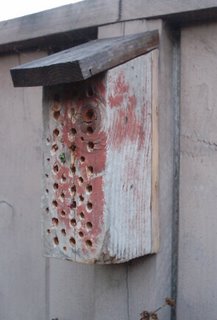A couple years ago I got interested in native bees of North America, and ordered some Orchard Mason bees from Knox Cellars. The bees arrive in a dormant state inside of soda straws, in which nests were built the previous season. These bees are not hive dwellers, but are solitary bees and build nests in cracks and crevices (and soda straws). Generally, they don't sting, presumably because they have no hive resources to protect. I built some nesting blocks for the next generation by drilling holes in wood blocks and mounting them on sun-warmed fences and walls in my yard. Many solitary bees prefer individual nests that are in close proximity to one another. This aids reproduction in the following year too, since Bobby Bee can literally stumble across a cute neighbor.
Unfortunately, all the Knox Cellars bees flew the coop (or hive). My nesting blocks were left empty that year. Hoping to attract some other solitary bees or beneficial wasps I drilled a few more different size holes to augment the existing 5/16" diameter holes and put out a vacancy sign. I have had a few takers: some of the smaller diameter holes (down at 1/8", I think) showed signs of occupancy. Whatever creature was living in there laid put a mud barrier over the hole. I never did find out what it was. However, the larger holes stayed empty. Until last week.
Last week I saw several holes covered with a neat circular green leaf patch, like a little manhole cover, stuck down over the fronts of nesting block holes. Within each hole are probably a handful of individual cells, each containing an egg. I was able to also observe the female bee preparing one of the cells, and it was a laborious process. I knew this wasn't a mason bee (they use mud mixed with other stuff). A little bit of googling tells me that it's probably a leafcutter bee, genus Megachile, species unknown. That's not surprising since there are many species of native and imported leafcutter bees in North America. Also see What's that bug?
Perhaps this bee was drawn to the native plants that have been in bloom in my front yard? I suppose that it could be coincidence that planted the natives last fall and the bee showed up for the first time now. However, for now I prefer to believe that clean living with a garden that fosters wildlife is the reason.
It turns out that with the decline of wild European honeybees due to urbanization, the varroa mite, Africanized honeybees, and other factors, that people are now looking to the wild solitary bees to polinate crops commercially. One leafcutter species (Megachile rotundata) is a solitary bee that has had a fair amount of success polinating alfalfa crops. It's an introduced species, but so is the honeybee. Generally, it seems to be regarded as a good addition to the bee mixture in North America, given our current problems. One recent study found that wild bees used to pollinate crops in combination with honeybees do a far better job than just one or the other alone. link
For the sunflower fields in the study, honey bees were stocked at the rate of 1.5 hives per acre. Of the 20,472 bee visits to sunflowers that Greenleaf observed, 72 percent were by honey bees from managed hives and the rest were by 32 different species of native wild bees, including carpenter bees and several bumble bees, leafcutter bee and digger bee species.
Greenleaf [the study's author] found that the wild native bees' pollination efficiency varied depending on species, from 0 to 19 seeds per visit. Overall, direct pollination from wild bees accounted for only 7 percent of total pollination in the sunflower fields. But by provoking honey bees to alter their behavior, wild bees were indirectly responsible for an additional 40 percent of the pollination. Honey bees on their own provided just 53 percent of the pollination.
In the meantime, I'll be keeping an eye on these nests and hope that the bees stick around.
 At left, a picture of one of my home made nesting blocks. Leafcutter nest is easily visible. Holes are 5/16". There's a mud nest in a smaller (1/8") hole immediately above the leafcutter nest. It's visible on the larger linked image.
At left, a picture of one of my home made nesting blocks. Leafcutter nest is easily visible. Holes are 5/16". There's a mud nest in a smaller (1/8") hole immediately above the leafcutter nest. It's visible on the larger linked image.
We visited the world's only bee santuary at Kangaroo Island. No africanized bees can fly across the ocean to this island!
ReplyDeletehttp://en.wikipedia.org/wiki/Kangaroo_Island